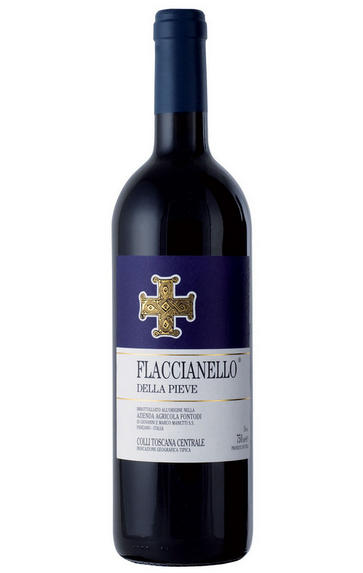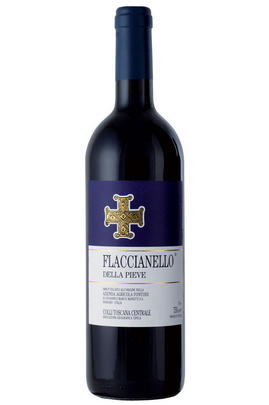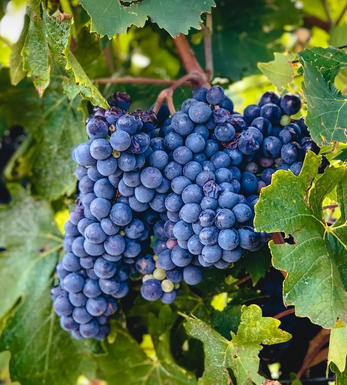
2013 Flaccianello della Pieve, Tenuta Fontodi, Tuscany, Italy

Critics reviews
Fontodi's 2013 Flaccianello della Pieve is a fabulous, riveting wine that grabs hold of all the senses. There is plenty of the richness and textural depth that have always been a Fontodi signature, but in the more contemporary style that seeks to marry power and elegance. Readers will have to be patient, as the 2013 is still very much in its inky, primary stage.
Drink 2023 - 2043
Antonio Galloni, Vinous.com (January 2018)
Made from 1981 from 100% selected Sangiovese, mainly at 500 m elevation. Aged for 24 months in French barriques where malo takes place. Average production 60,000 bottles.
So light and pure! Much more approachable than the Vigna del Sorbo. Really racy, this sings loudly. Spicy and glorious. Wonderful purity.
Drink 2018 - 2035
Jancis Robinson MW, JancisRobinson.com (June 2018)
The gorgeous 2013 Flaccianello della Pieve is going through a closed phase at the moment. Let's give the wine a few more years to sort itself out. This window of momentary shyness is a very encouraging sign when you consider how far this wine will travel to complete its evolutionary path. This vintage saw a cool spring that got the season off to a late start. Mild summer temperatures meant that the harvest also came later, with fruit picked the first week of October.
The natural characteristics of this vintage include higher total acidity, increased tannic structure and slightly lower alcohol content. The 2013 Flaccianello hits the trifecta of positive potential aging attributes. Indeed, the wine is almost rigid and nervous at this early stage in its adolescence. Like proud parents, we will wait and watch this bottle blossom over time.
Drink 2019 - 2045
Monica Larner, Wine Advocate (July 2019)
From organically grown grapes. Pure Sangiovese.
Very precise and focused with blueberry, blackberry and currant character. Chewy yet tight tannins. Full body and fabulous density and length. A classic. Needs five or six years to open completely but so beautiful in its youth. Real deal.
James Suckling, JamesSuckling.com (November 2016)
A warm rather than hot vintage with cool periods throughout. Harvest was relatively late, commencing at the beginning of October. Manetti tells me he reduced the time in barriques to 18 months, with the remaining six months spent in large casks - for this and subsequent vintages. This is so elegantly proportioned and refined, with ethereal fragrances of wildflowers and forest berries. The buoyant palate almost belies its depth and the finish resonates with minerality. A pure expression of Sangiovese and proof that a wine does not need to be large and brawny to be excellent or age-worthy.
Drink 2022 - 2035
Michaela Morris, Decanter.com (October 2018)
About this WINE

Fontodi
Fontodi is located in the hills south of the town of Panzano in the heart of the Chianti Classico region.This 90-hectare estate was in a run down and derelict state when it was acquired by Domiziano and Dino Manetti in 1968. They totally replanted the vineyards and renovated the winemaking facilities and today Fontodi is recognised as one of the finest producers in the region.
The estate is now run by Macro and Gioivanni Manetti, ably assisted by winemaker Franco Bernabei. Its benchmark Chianti Classico is made from a blend of Sangiovese and Canaiolo and aged in large oak barrels whereby the Chianti Classico Riserva has a small amount of Cabernet Sauvignon in the blend, and a portion is aged in small French barriques. Its finest wine is the 100% Sangiovese, Flaccinello della Pieve.

IGT Tuscany
IGT (Indicazione Geografica Tipica) Tuscany is a wine classification from Italy's Tuscany region. It is one of the official wine classifications recognized by the Italian government. IGT is a step below the highest classification, DOCG (Denominazione di Origine Controllata e Garantita), and above the DOC (Denominazione di Origine Controllata) level.
The IGT classification was introduced in 1992 to allow winemakers more flexibility in grape varieties and employ winemaking techniques while still ensuring a certain level of quality and geographical indication. This classification gives winemakers more freedom to experiment and innovate, deviating from the strict regulations of the DOC and DOCG classifications.
IGT Tuscany wines can be produced throughout the entire region of Tuscany, encompassing various sub-regions and terroirs within the area. This classification allows winemakers to use traditional Tuscan grape varieties, such as Sangiovese, and non-traditional grape varieties, including international ones like Cabernet Sauvignon, Merlot, Syrah, and others.
The IGT Tuscany classification gives winemakers the flexibility to create wines that showcase the unique characteristics of their specific vineyards and winemaking styles. It allows for experimentation with blending different grape varieties, using innovative winemaking techniques, and exploring new regional vineyard sites.
IGT Tuscany wines can vary greatly, from traditional and terroir-driven expressions to more modern and international styles. This classification has played a significant role in developing Super Tuscan wines, often IGT designated and known for their high quality and international recognition.
Overall, IGT Tuscany provides a platform for winemakers in the region to express their creativity and produce wines that reflect their unique vision while maintaining a connection to the rich heritage and traditions of winemaking in Tuscany.

Sangiovese
A black grape widely grown in Central Italy and the main component of Chianti and Vino Nobile di Montepulciano as well as being the sole permitted grape for the famed Brunello di Montalcino.
It is a high yielding, late ripening grape that performs best on well-drained calcareous soils on south-facing hillsides. For years it was blighted by poor clonal selection and massive overcropping - however since the 1980s the quality of Sangiovese-based wines has rocketed upwards and they are now some of the most sought after in the world.
It produces wines with pronounced tannins and acidity, though not always with great depth of colour, and its character can vary from farmyard/leather nuances through to essence of red cherries and plums. In the 1960s the advent of Super Tuscans saw bottlings of 100% Sangiovese wines, as well as the introduction of Sangiovese/Cabernet Sauvignon blends, the most famous being Tignanello.


Buying options
Add to wishlist
Description
The gorgeous 2013 Flaccianello della Pieve is going through a closed phase at the moment. Let's give the wine a few more years to sort itself out. This window of momentary shyness is a very encouraging sign when you consider how far this wine will travel to complete its evolutionary path. This vintage saw a cool spring that got the season off to a late start. Mild summer temperatures meant that the harvest also came later, with fruit picked the first week of October.
The natural characteristics of this vintage include higher total acidity, increased tannic structure and slightly lower alcohol content. The 2013 Flaccianello hits the trifecta of positive potential aging attributes. Indeed, the wine is almost rigid and nervous at this early stage in its adolescence. Like proud parents, we will wait and watch this bottle blossom over time.
Drink 2019 - 2045
Monica Larner, Wine Advocate (July 2019)
wine at a glance
Delivery and quality guarantee